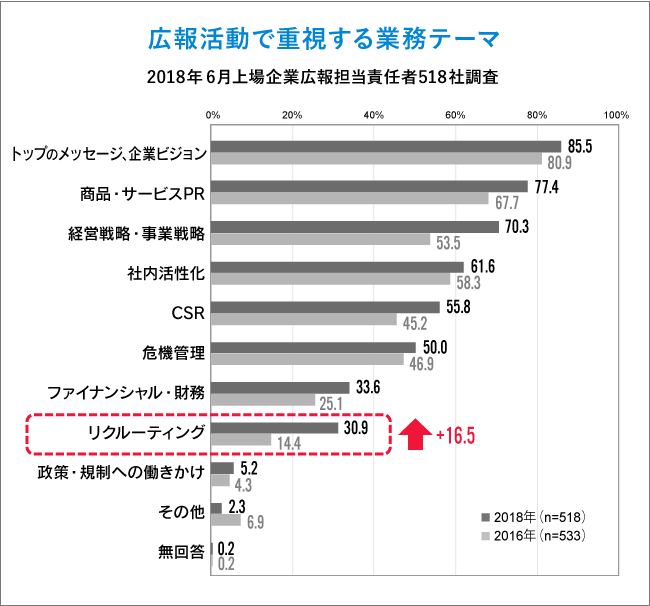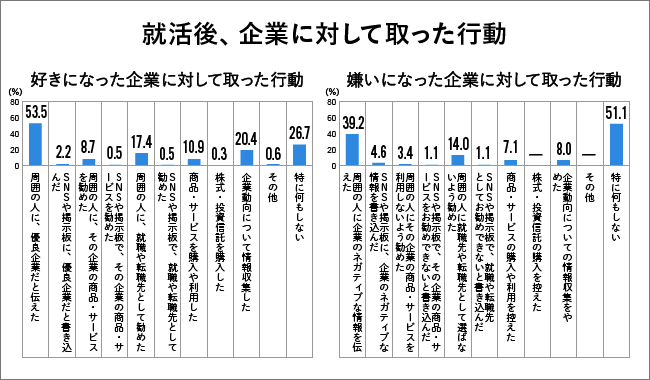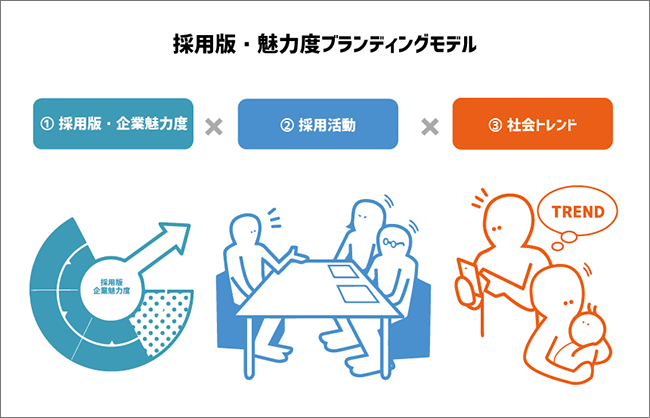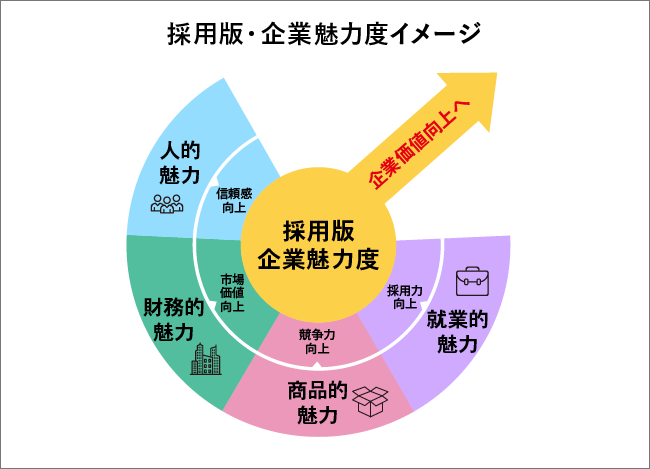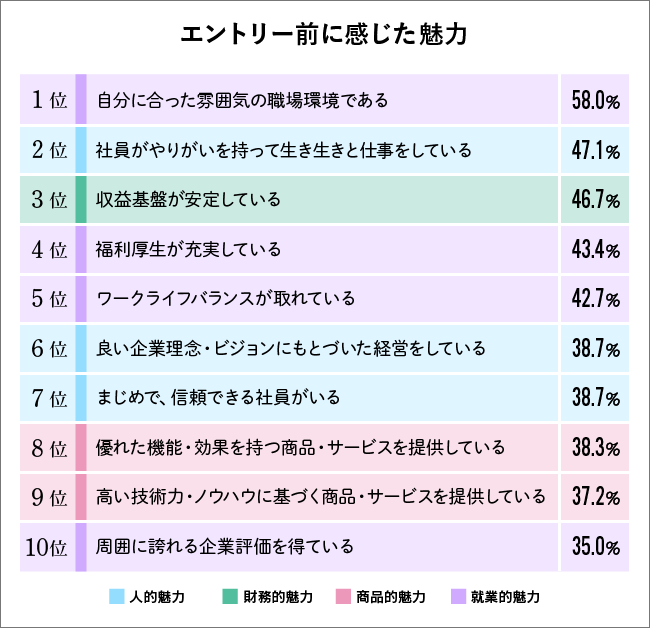In today's job market, students hold the upper hand in a highly competitive environment. We've moved from an era where companies selected students to one where students choose companies. Consequently, corporate recruitment activities are drawing significant attention.
At the Corporate Communications Strategy Institute, a research organization within Dentsu Inc. PR, we believe that recruitment events—where people (job-seeking students) gather—represent a significant opportunity for corporate branding. It's crucial to view these events not just as recruitment, but as a public relations activity that the entire company should engage in collectively.
To effectively communicate with job-seeking students at these recruitment events, we collaborated with experts to develop the "Recruitment Attractiveness Branding Model," an indicator measuring a company's appeal from the student's perspective.
This series will introduce, over three installments, the survey results of job seekers based on this model and the key points analyzed from them for linking recruitment activities to corporate branding.
Companies have entered an era where they must be chosen!
"Recruitment" becomes a key theme requiring company-wide collaboration
In a society facing a declining birthrate, "recruitment" has become one of the most critical management issues for companies. Our institute's survey of PR managers at listed companies also shows recruitment growing as a key theme.
In 2018, "Recruiting" rose 16.5 percentage points from the previous 2016 survey to 30.9% as a "Theme Emphasized in PR Activities," while "Job Seekers/Students" increased 18.4 percentage points to 66.8% as a "Stakeholder Emphasized."
Recruitment is no longer solely the responsibility of hiring managers; it has become a theme requiring company-wide, cross-departmental collaboration, including PR.
Job seekers are important stakeholders for companies over the medium to long term
Companies conduct recruitment activities targeting job seekers scheduled to join the following year. It is essential to recognize that these job seekers are important stakeholders for the company on two axes: "present" and "future."
In the "present," job seekers actively gather and share information via smartphones, the internet, and social media. Information about a company's activities, not just recruitment, can spread rapidly online. Furthermore, this disseminated information gets archived in various forms—online forums, news articles—and impacts the company's reputation. Therefore, it's essential to recognize that all job seekers are important stakeholders, not just those who ultimately join the company.
And then there's the "future." To navigate an uncertain economic environment, talented students who join the company become important stakeholders, of course. But even if they don't join, they could become future customers, business partners, or shareholders. Maintaining connections with talented individuals outside the company is even more crucial in an era demanding open innovation.
90% of job seekers evaluate companies through recruitment. If they like a company, they will continue supporting it
According to our institute's survey, when asked whether they had ever developed a positive or negative impression of a company through job hunting, 11.7% responded that their impression had never changed. This indicates that approximately 90% of job seekers evaluate companies through the job hunting process.
Furthermore, when asked if they would continue supporting companies they grew to like, 98.1%—nearly all respondents—said they would.
Additionally, when asked if they took action regarding companies they grew to like or dislike, three out of four took action regarding companies they liked, while one out of two took action regarding companies they disliked.
Companies and job-hunting students have various points of contact in daily life through media, advertising, products/services, store staff, e-commerce sites, etc. However, during the job-hunting process, additional rich points of contact are added, such as recruitment events, visits with alumni, recruitment staff, and internships.
For students, job hunting is also a valuable opportunity to proactively gather information about specific companies. These interactions are crucial for corporate branding. To maximize this opportunity, companies need to somehow spark initial interest in their organization.
The Three Key Elements Job-Hunting Students Focus On
To measure a company's appeal to job seekers, our institute developed the "Attractiveness Branding Model for Recruitment" in collaboration with recruitment consultant and analyst Masanao Tanide. This model is based on our proprietary "Attractiveness Branding Model" developed in 2016.
This model consists primarily of three elements that influence job seekers:
1. The company's appeal from the job seeker's perspective: "Recruitment-focused Corporate Appeal"
The first element is "Recruitment-Oriented Company Attractiveness."
It consists of four categories and 48 items (12 items per category), adding "Employment Appeal"—which assumes the job seeker will work at the company—to the three existing appeal categories: "Human Appeal," "Financial Appeal," and "Product Appeal." This model organizes what aspects of a specific company job seekers find interesting and where they focus their attention.
・Human Appeal: The appeal of the "individuals" who make up the company and the appeal of the "corporate entity" as perceived through its business activities.
・Financial Appeal: The appeal of excellent management systems and financial performance, along with the mechanisms and initiatives supporting them
・Product Appeal: The appeal conveyed through the company's products and services
・Employment Appeal: The appeal felt when actually working at the company, such as its corporate culture and workplace environment
"Employment Appeal" is particularly crucial as it forms the foundation for one's work experience and is a key appeal point when leveraging recruitment for PR.
2. Job seekers evaluate the "recruitment activities" themselves
The second factor is the recruitment activities themselves. For example, engaging recruiters directly influence the company's overall reputation. Implementing a clear and transparent selection process also serves as a key differentiator.
3. Social trends that resonate with job seekers
The third factor is societal trends gaining attention, such as work-style reform, technological innovation, and women's advancement.
Job hunting makes work a tangible reality for students, prompting them to view social trends as personally relevant. Whether a company demonstrates empathy and alignment with the social trends job seekers care about is a major factor influencing their evaluation.
Job seekers evaluate companies based on the combination of these three elements, making consistent recruitment and corporate activities essential.
The key point is that these three elements are multiplicative, not additive. While large and well-known companies generally have higher corporate appeal and an advantage, small and medium-sized venture companies can potentially surpass major corporations by leveraging other elements.
Job seekers evaluate corporate appeal from multiple angles
A survey of 1,000 job seekers based on this "Recruitment Attractiveness Branding Model" revealed that while "Employment Attractiveness" accounted for a relatively large proportion, job seekers also consider "Human Capital Attractiveness," "Financial Attractiveness," and "Product Attractiveness."
This trend was also reflected in the top 10 rankings selected by job seekers from the 48 items across the 4 categories.
Digital native job seekers base their judgments not only on their own job-hunting experiences but also on social media and review sites. Furthermore, "human appeal," "financial appeal," and "product appeal" are formed through the accumulation of daily corporate activities.
This is why recruitment activities and corporate branding are so closely intertwined.
Focusing solely on the recruitment period, promoting only convenient aspects without substance, or concentrating solely on attention-grabbing recruitment PR risks creating a mismatch with today's job seekers' evaluation criteria and could actually damage the corporate brand.
In the next installment and beyond, we will discuss how to build corporate branding through recruitment activities, based on an understanding of this background.

